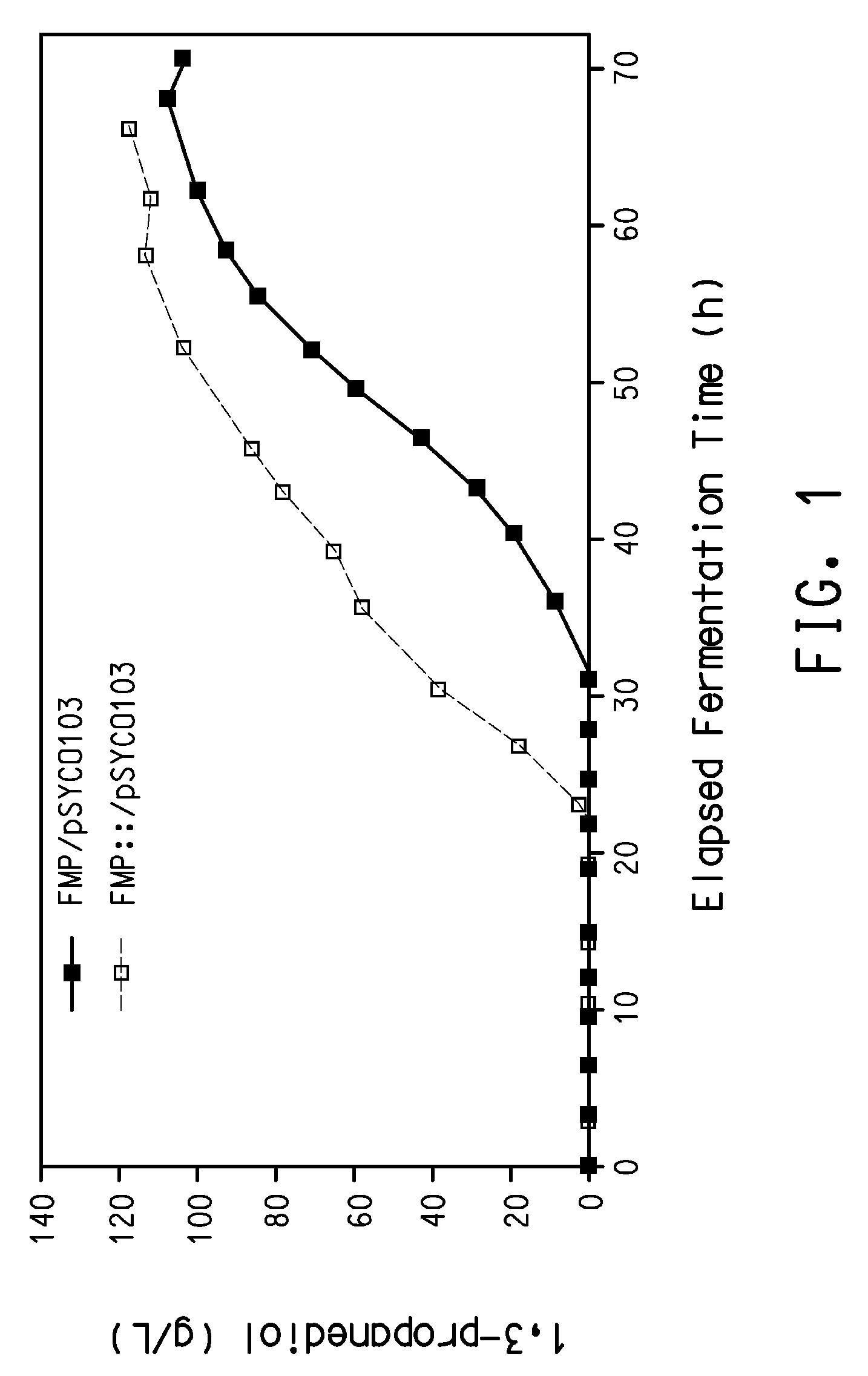Process for the biological production of 1,3-propanediol with high yield
a technology of 1,3-propanediol and biological production, which is applied in the field of biological production of 1,3-propanediol with high yield, can solve the problems of complex cofactor requirements, less efficient kinetic parameters, and waste streams containing environmental pollutants, and achieves the effect of higher yield
- Summary
- Abstract
- Description
- Claims
- Application Information
AI Technical Summary
Benefits of technology
Problems solved by technology
Method used
Image
Examples
example 1
Construction of NADH Dehydrogenase II Minus (Δndh) E. coli Strains for the Production of 1,3-propanediol
Construction of KLndh81.
[0272]An ndh mutation was obtained by interrupting the coding region with a loxP511 cassette. The ndh gene (for reference, see GenBank, Accession # U00096), with upstream and downstream flanking regions, was PCR amplified from E. coli MG1655 and cloned. The ndh cassette was digested with Stu I, cutting roughly in the middle of the gene, and a loxP511-Cat-loxP511 cassette was cloned into this site with the cat gene in the opposite orientation relative to the ndh gene. The loxP511-Cat-loxP511 cassette was obtained from the plasmid pLoxCat27 [SEQ ID NO:1] by digestion with Spe I and EcoR V, followed by fill-in to generate blunt ends, and gel purification of the 1.1 kb fragment. The loxP511 site is a variant of the loxP site (Palmeros et al., supra). The ndh::Cat cassette was PCR amplified and electroporated into KLP23 competent cells creating strain KLndh81::C...
example 2
Comparison of 1,3-Propanediol and Glycerol Production with E. coli Strains KLP23 / pAH48 / pDT29 and KLP23 / pAH48 / pKP32
[0274]Strain KLP23 was transformed with plasmids pAH48 and pDT29 or pKP32. Production of 1,3-propanediol (and glycerol) was determined in 14 L fermenters as described in General Methods. Pre-cultures for each fermentation were prepared using frozen vials thawed and grown in 500 mL 2YT with 200 mg / L carbenicillin and 50 mg / L spectinomycin. The full contents of the flask were used to inoculate the fermenter. The fermenter was operated at 35° C. and a d6 set-point of 10%; all other control parameters are as described in General Methods. The vitamin B12 strategy for each fermentation is detailed below.
Fermentation with KLP23 / pAH48 / pDT29.
[0275]In this example, vitamin B12 (0.075 g / L, 500 mL) was fed, starting 3 h after inoculation, at a rate of 16 mL / h. A representative fermentation summary of the conversion of glucose to 1,3-propanediol (1,3-PD) using E. coli strain KLP23 / pA...
example 2a
Comparison of 1,3-Propanediol and Glycerol Production with E. coli Strains RJ8 / pAH48 / pDT29 and RJ8 / pAH48 / pKP32
[0281]RJ8 / pAH48pDT29 and RJ8 / pAH48 / pKP32 pre-cultures were prepared using frozen vials thawed and grown in 500 mL 2YT with 200 mg / L carbenicillin and 50 mg / L spectinomycin. The full contents of the flask were used to inoculate the fermenter. The fermenter was operated at 35° C. and a d6 set-point of 10%; all other control parameters are as described in General Methods. RJ8 / pAH48 / pKP32 is identical to RJ8 / pAH48 / pDT29 except that dhaT is deleted. The vitamin B12 strategy for each fermentation is detailed below.
Fermentation with RJ8 / pAH48 / pDT29.
[0282]A representative fermentation summary of the conversion of glucose to 1,3-propanediol (1,3-PD) using E. coli strain RJ8 / pAH48 / pDT29 is given in Table 2A.1. Vitamin B12 was provided as bolus additions of 2, 16 and 16 mg at 2, 8, and 26 h, respectively. The yield of 1,3-propanediol was 35 wt % (g 1,3-propanediol / g glucose consumed) a...
PUM
 Login to View More
Login to View More Abstract
Description
Claims
Application Information
 Login to View More
Login to View More - R&D
- Intellectual Property
- Life Sciences
- Materials
- Tech Scout
- Unparalleled Data Quality
- Higher Quality Content
- 60% Fewer Hallucinations
Browse by: Latest US Patents, China's latest patents, Technical Efficacy Thesaurus, Application Domain, Technology Topic, Popular Technical Reports.
© 2025 PatSnap. All rights reserved.Legal|Privacy policy|Modern Slavery Act Transparency Statement|Sitemap|About US| Contact US: help@patsnap.com

